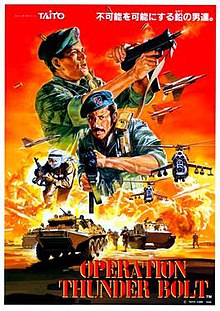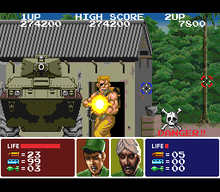| Operation Thunderbolt | |
|---|---|
 Promotional flyer Promotional flyer | |
| Developer(s) | Taito |
| Publisher(s) | Taito |
| Designer(s) | Junji Yarita Hiroyuki Sako |
| Programmer(s) | Daisuke Sasaki Akira Ōtsuki Youzou Koma Tatsuo Nakamura Shinji Soyano |
| Artist(s) | Hiroyasu Nagai Osamu Matsuura Junji Yarita Yoshihiko Wakita Minori Ishino Taira Sanuki Hisakazu Kato |
| Composer(s) | Shizuo Aizawa |
| Platform(s) | Arcade |
| Release | September 14, 1988 |
| Genre(s) | Light gun shooter |
| Mode(s) | Single-player, co-op |
Operation Thunderbolt is a light gun shooter video game developed by Taito and released for arcades in 1988. As the sequel to Operation Wolf, changes include two-player gameplay with two positional gun controllers mounted on the arcade cabinet, and a new forward-scrolling pseudo-3D perspective combined with side-scrolling sections.
The arcade game was a commercial success and was one of the top three highest-grossing dedicated arcade games of 1989 in both Japan and the United States. Versions were released for Amiga, Commodore 64, and Super Nintendo Entertainment System. The arcade exclusive sequel Operation Wolf 3 was released in 1994.
Gameplay
Green berets Roy Adams and Hardy Jones must save American hostages from a hijacked airliner which was forced to land in the fictional African province, Kalubya. They must capture six different bases, shoot enemies with machine guns or grenade launcher, and try to save the hostages. Enemies include soldiers, jeeps, tanks, and helicopters, attacking with bullets, grenades, or rockets.
In stages 4 and 6, killing one of the hostages will decrease the player's life. At least one hostage must be rescued in those stages, or the game is over. In Stage 8, the players must engage with the lead hijacker holding the pilot hostage. Continues are not permitted. If the pilot gets killed, a bad ending will be shown "The pilot is dead; escape is impossible". If the hijacker is killed, the good ending will be shown where the player and hostages flee the hostile nation, with the plane's takeoff.
Changes from Operation Wolf include the arcade cabinet using positional gun controllers instead of light gun, two-player simultaneous play with two mounted guns, and a new forward-scrolling pseudo-3D perspective combined with side-scrolling sections.
Ports

Ocean Software published conversions of Operation Thunderbolt for the Amiga, Amstrad CPC 464, Atari ST, Commodore 64, and ZX Spectrum in 1989. A cartridge version for the Amstrad GX4000 followed in 1993.
The Super NES version was released by Taito in 1994 and works with the SNES Mouse and the Super Scope. The player can choose from a variety of different characters. The storyline was altered so that the hijackers were members of the fictional Bintazi People's Republic, under lifelong dictator General Abul Bazarre, who demands that his comrades be freed or the hostages will be executed.
Influence
The story for the game is loosely based on the plot of the film by the same name, which in turn was based on the real-life Entebbe raid that occurred on July 4, 1976.
Reception
Reception| Publication | Score | ||||
|---|---|---|---|---|---|
| Amiga | Arcade | PC | SNES | ZX | |
| ACE | 927 | 815 (CPC) | 805 | ||
| Crash | Positive | 91% | |||
| Computer and Video Games | Positive | 80% (CPC) | 80% | ||
| GamePro | 16/20 | ||||
| Next Generation | |||||
| Sinclair User | 7/10 | 92% | |||
| The Games Machine (UK) | Positive | 91% | |||
| Your Sinclair | 93% | ||||
| Commodore User | 9/10 | ||||
| Publication | Award |
|---|---|
| Crash | Best Graphics, Crash Smash |
| UK game industry | Best 16-bit arcade license translation |
| Sinclair User | SU Classic |
| Your Sinclair | Megagame |
| Zzap!64 | Gold Medal |
| This section needs expansion. You can help by adding to it. (August 2021) |
In Japan, Game Machine listed Operation Thunderbolt in its February 1, 1989 issue as the second most successful upright arcade unit of the month. It became Japan's second highest-grossing dedicated arcade game of 1989, below Chase H.Q. In the United States, Operation Thunderbolt was the third highest grossing dedicated arcade game of 1989. Operation Thunderbolt was also Japan's eighth highest-grossing dedicated arcade game of 1990.
Reviews
The arcade game received positive reviews from critics, upon release. Commodore User said it "takes all the best elements" of Operation Wolf, including "the brilliant graphics" and "action blasting", and added "a two-player option, a brand new perspective and some really clever scenario ideas".
Reviewing the Super NES version, GamePro praised the colorful and detailed graphics and strong sound effects, but criticized the repetitiveness of the gameplay and the slowness of the aiming reticule, and concluded that this Operation is a success. A reviewer for Next Generation dismissed it as another shooting-gallery game.
Accolades
The game won the 1989 award for best graphics of the year according to the readers of Crash magazine.
At a British game industry awards event held at the end of 1989, Operation Thunderbolt was awarded "Best 16-bit arcade license translation" for Ocean Software's home computer conversions.
Legacy
Operation Thunderbolt is in the Taito Legends compilation for Microsoft Windows, PlayStation 2, and Xbox.
See also
- Operation Wolf (1987)
- Line of Fire (1989)
- Space Gun (1990)
- Operation Gunbuster (1992)
References
- "Operation Thunderbolt (Registration Number PA0000409101)". United States Copyright Office. Retrieved 5 August 2021.
- Martyn Carroll. "Ultimate Guide: Operation Thunderbolt". Retro Gamer. No. 153. p. 36.
Rather than using lightguns the sequel utilised a pair of positional guns that directly controlled invisible cursors on the screen
- ^ Kelly, Nick (26 January 1989). "Arcades: Operation Thunderbold (arcade star)". Commodore User. No. 65 (February 1989). pp. 92–3.
- ^ Martyn Carroll. "Ultimate Guide: Operation Thunderbolt". Retro Gamer. No. 139. p. 40.
- "Cart Reviews". Amstrad Action. No. 98. p. 48.
- "Let's Get Technical". GamePro. No. 76. IDG. January 1995. p. 14.
- "Buyers Beware". GamePro. No. 98. IDG. November 1996. p. 24.
- ^ "Operation Thunderbolt Review". ACE. No. 29. 1990. p. 48.
- ^ "Arcade game reviews". Solvalou.com. Retrieved 25 February 2021.
- "Operation Thunderbolt Review". Crash. No. 71. 1989. pp. 62–3.
- ^ "Operation Thunderbolt Review". Computer & Video Games. No. 98. 1990. p. 100.
- ^ "ProReview: Operation Thunderbolt". GamePro. No. 76. IDG. January 1995. p. 74.
- "Operation Thunderbolt Review". Sinclair User. No. 94. 1990. pp. 102–3.
- "Operation Thunderbolt Review". Your Sinclair. 1989. pp. 18–9.
- ^ "Operation Thunderbolt". Next Generation. No. 6. Imagine Media. June 1995. p. 113.
- "Operation Thunderbolt Review". The Games Machine. No. 25. 1989. p. 86.
- ^ "CRASH 75 – Readers' Awards". crashonline.org.uk. Retrieved 2015-09-06.
- ^ "Kick Off Top of the League". Zero. No. 5. Dennis Publishing. March 1990. pp. 8–9.
- Game review, Zzap!64 issue 57, January 1990, page 14
- "Game Machine's Best Hit Games 25 - アップライト, コックピット型TVゲーム機 (Upright/Cockpit Videos)". Game Machine (in Japanese). No. 349. Amusement Press, Inc. 1 February 1989. p. 25.
- "Videos of The Year; "Tetris", "Chase H.Q."" (PDF). Game Machine (in Japanese). No. 372. Amusement Press, Inc. 15 January 1990. p. 26.
- "Special Report: 1989's Best Videos and Pins". RePlay. Vol. 15, no. 4. January 1990. pp. 44, 46, 4.
- "Coin Machine: AMOA Games Awards Nominees Announced". Cash Box. July 29, 1989. p. 25.
- ""Tetris" Has Still Earned More Than "Final Fight"" (PDF). Game Machine (in Japanese). No. 396. Amusement Press, Inc. 1 February 1991. p. 22.
External links
- Operation Thunderbolt at the Killer List of Videogames
- Operation Thunderbolt at SpectrumComputing.co.uk
| Operation Wolf series | |
|---|---|
| Collections |
|
| Compilations | |
- 1988 video games
- Amiga games
- Amstrad CPC games
- Arcade video games
- Atari ST games
- Commodore 64 games
- Cooperative video games
- Crash Smash! award winners
- Light gun games
- Ocean Software games
- Rail shooters
- Super Nintendo Entertainment System games
- Video games about terrorism
- Video games scored by Hisayoshi Ogura
- ZX Spectrum games
- Video game sequels
- Taito arcade games
- Video games developed in Japan
- Multiplayer and single-player video games